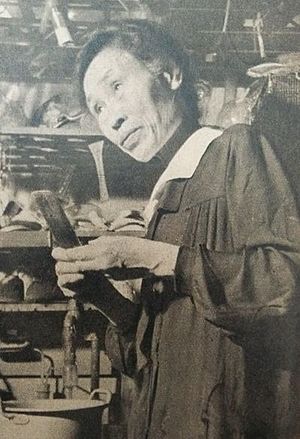Chika Kuroda facts for kids
Quick facts for kids
Chika Kuroda
|
|
|---|---|

Chika Kuroda in 1948
|
|
| Born | 24 March 1884 |
| Died | 8 November 1968 (aged 84) |
| Other names | 黒田チカ |
| Awards | Majima Prize |
| Academic background | |
| Alma mater | Kenkyuka Women's Higher Normal School Tohoku Imperial University |
| Influences | Riko Majima William Henry Perkin |
| Academic work | |
| Institutions | Tokyo Women's Higher Normal School, Tohoku Imperial University Ochanomizu University |
| Main interests | Organic chemistry |
| Notable ideas | Natural dye |
Chika Kuroda (born March 24, 1884 – died November 8, 1968) was a Japanese chemist. She studied natural colors found in plants. She was also the very first woman in Japan to earn a Bachelor of Science degree.
Contents
Chika Kuroda's Life Story
Chika Kuroda was born in 1884 in Saga Prefecture, Japan. She went to Saga Normal School and finished in 1901. After that, she worked as a teacher for one year.
In 1902, she started studying science at Rika Women's Higher Normal School. She graduated in 1906. She taught at Fukui Normal School for a year. Then, in 1907, she joined a special graduate program at Kenkyuka Women's Higher Normal School. She finished this program in 1909. After that, she became an assistant professor at Tokyo Women's Higher Normal School.
Becoming a Pioneer in Science
In 1913, Tohoku Imperial University made history. It became the first of Japan's big universities to let women study there. Chika Kuroda was one of the first women accepted into the Chemistry Department.
There, she met Professor Riko Majima. He helped her become interested in organic chemistry, especially natural pigments (colors from nature). He guided her research into the purple color found in a plant called Lithospermum erythrorhizon. In 1916, she earned her Bachelor of Science degree. This made her the first woman in Japan to achieve this.
Continuing Her Research
After graduating in 1916, Chika Kuroda became an assistant professor at Tohoku Imperial University. In 1918, she became a full professor at Tokyo Women's Higher Normal School. That same year, she was the first woman to present her research to the Chemical Society of Japan. She talked about the purple color she studied.
In 1921, she traveled to the University of Oxford in England. There, she did more research with a famous scientist named William Henry Perkin. She came back to Japan in 1923 and continued her work as a professor.
In 1924, a research institute called RIKEN asked her to study carthamin. This is the red pigment found in safflower plants. Her detailed study on carthamin helped her earn a doctorate degree in science in 1929. She was the second woman in Japan to get such a high science degree, after Kono Yasui.
Later Career and Achievements
During the 1930s and 1940s, Kuroda kept studying colors from nature. She looked at the pigments in plants like the Asiatic dayflower, eggplant skin, black soybeans, red shiso leaves, and even sea urchin spines.
In 1936, she received the Majima Prize from the Chemical Society of Japan. This was a big award for her work.
In 1949, she became a professor at Ochanomizu University. At the same time, she started researching the color of onion skin. She found special crystals called quercetin in onion skin. This discovery led to a medicine called Kerutin C, which helps lower blood pressure.
She retired in 1952 but continued to teach at Ochanomizu University as a professor emeritus. This means she was a respected former professor. She received a special honor called a Medal with Purple Ribbon in 1959. In 1965, she received another high honor, the Order of the Precious Crown of the Third Class.
Chika Kuroda developed heart disease in 1967. She passed away on November 8, 1968, in Fukuoka, at the age of 84.
Chika Kuroda's Legacy
Chika Kuroda left a lasting impact on science in Japan. In 1999, Tohoku University created the Chika Kuroda Prize. This award recognizes excellent achievements by graduate students in science. It helps remember her important contributions and inspires new scientists.
See also
 In Spanish: Chika Kuroda para niños
In Spanish: Chika Kuroda para niños

